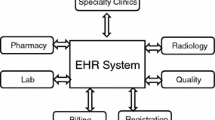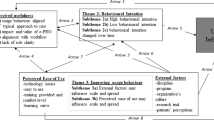Abstract
Information and communication technologies are known to be instrumental in the enhancement of healthcare management capabilities in developing countries. Turkey – a developing country – has undergone a major healthcare transformation marked by the redesign of primary care delivery and the implementation of a nation-wide Electronic Health Records (EHR) system. In this research, presenting Turkey’s case, we investigate the consequences of EHR implementation in developing countries. We argue that to better understand the consequences, we need to link macro-level healthcare goals with micro-level system usage behaviors that actualize the macro-level goals or alternatively result in unintended negative health outcomes. We posit that this linkage is achieved through the meso-level structures, namely the EHR and the organizational context, in which it is embedded. Hence, we examine the EHR’s role in this relationship. Our findings indicate that EHR usage both enables and constrains the achievement of clinicians’ professional goals in the context of primary care delivery. Moreover, goal alignment between the government agency as the designer of the system and the clinicians influence the outcomes of the EHR-enabled transformation. When the healthcare goals are aligned, the system enables the clinicians to achieve their professional goals and their system usage behaviors converge, contributing to improvements in health outcomes. Contrarily, when the goals are misaligned, the system constrains goal achievement and the clinicians show divergent usage behaviors, including goal abandonment. In turn, goal abandonment may lead to negative consequences and even adversely affect the achievement of population-level healthcare goals in the long run.


Similar content being viewed by others
References
Aile Hekimligi. [WWW document]. (2016). http://ailehekimligi.gov.tr/ [accessed 13th January 2016].
Akdag, R. (2009). Progress Report Health Transformation Programme. Ankara: Ministry of Health of Turkey.
Atun, R. (2015). Transforming Turkey’s Health System—Lessons for Universal Coverage, New England Journal of Medicine 373(14): 1285–1289.
Avgerou, C. (2010). Discourses on ICT and Development, Information Technologies & International Development 6(3): 1–18.
Blaya, J.A., Fraser, H.S. and Holt, B. (2010). E-health Technologies Show Promise in Developing Countries, Health Affairs 29(2): 244–251.
Bodvala, R. (2002). ICT Applications in Public Healthcare System in India: A Review, ASCI Journal of Management 31(1): 56–66.
Braa, J., Monteiro, E. and Sahay, S. (2004). Networks of Action: Sustainable Health Information Systems Across Developing Countries, MIS Quarterly 28(3): 337–362.
Cayhan, B.E. (2008). Implementing E-Government in Turkey: A Comparison of Online Public Service Delivery in Turkey and the European Union, The Electronic Journal of Information Systems in Developing Countries 35(8): 1–11.
Chaudhry, B., Wang, J., Wu, S., Maglione, M., Mojica, W., Roth, E., et al. (2006). Systematic Review: Impact of Health Information Technology on Quality, Efficiency, and Costs of Medical care, Annals of Internal Medicine 144(10): 742–752.
Clifford, G.D., Blaya, J.A., Hall-Clifford, R. and Fraser, H.S. (2008). Medical Information systems: A Foundation for Healthcare Technologies in Developing Countries, BioMedical Engineering OnLine 7(1): 18–25.
De Maeseneer, J., Van Weel, C., Egilman, D., Mfenyana, K., Kaufman, A., Sewankambo, N., et al. (2008). Funding for Primary Health Care in Developing Countries, British Medical Journal 336(7643): 518–519.
Fayard, A.L. and Weeks, J. (2014). Affordances for Practice, Information and Organization 24(4): 236–249.
Fraser, H.S.F., Biondich, P., Moodley, D., Choi, S., Wamlin, B.W. and Szolovits, P. (2005). Implementing Electronic Medical Record Systems in Developing Countries, Informatics in Primary Care 13, 83–95.
Freedman, L.P., Waldman, R.J., de Pinho, H., Wirth, M.E., Chowdhury, A.M.R. and Rosenfield, A. (2005). Transforming Health Systems to Improve the Lives of Women and Children, The Lancet 365(9463): 997–1000.
Gibson, J.J. (1986): The Ecological Approach to Visual Perception, Hillsdale, NJ: Lawrence Erlbaum Associates.
Gosain, S. (2004). Enterprise Information Systems As Objects and Carriers of Institutional Forces: The New Iron Cage? Journal of the Association for Information Systems 5(4): 151–182.
Heeks, R. (2003): Most e-Government for Development Projects Fail: How Can Risks Be Reduced?, In iGovernment Working Paper Series, Paper No. 14 Manchester, UK: Institute for Development Policy and Management, University of Manchester.
Heeks, R. (2006). Health Information Systems: Failure, Success and Improvisation, International Journal of Medical Informatics 75(2): 125–137.
Hultin, L. and Mähring, M. (2014). Visualizing Institutional Logics in Sociomaterial Practices, Information and Organization 24(3): 129–155.
Hutchby, I. (2001). Technologies, Texts and Affordances, Sociology 35(2): 441–456.
Jensen, T.B., Kjærgaard, A. and Svejvig, P. (2009). Using Institutional Theory with Sensemaking Theory: A Case Study of Information System Implementation in Healthcare, Journal of Information Technology 24(4): 343–353.
Kaplan, E. (2016). Saglikta Yeni Taslak: Sevk Almadan Hastane Yok, Cumhuriyet retrieved from http://www.cumhuriyet.com.tr.
Kekki, P. (2004): Primary Health Care and the Millennium Development Goals: Issues for Discussion, Geneva: WHO.
Kimaro, H. and Nhampossa, J. (2007). The Challenges of Sustainability of Health Information Systems in Developing Countries: Comparative Case Studies of Mozambique and Tanzania, Journal of Health Informatics in Developing Countries 1(1): 1–10.
Kimaro, H.C. and Sahay, S. (2007). An Institutional Perspective on the Process of Decentralization of Health Information Systems: A Case Study from Tanzania, Information Technology for Development 13(4): 363–390.
Leonardi, P.M. (2011). When Flexible Routines Meet Flexible Technologies: Affordance, Constraint, and the Imbrication of Human and Material Agencies, MIS Quarterly 35(1): 147–167.
Leonardi, P.M. and Barley, S.R. (2008). Materiality and Change: Challenges to Building Better Theory About Technology and Organizing, Information and Organization 18(3): 159–176.
Luna, D., Almerares, A., Mayan, J.C., Bernaldo, Gonzalez, de Quiros, F. and Otero, C. (2014). Health Informatics in Developing Countries: Going Beyond Pilot Practices To Sustainable Implementations: A Review of the Current Challenges, Healthcare Informatics Research 20(1): 3–10.
Luna, D., Otero, C. and Marcelo, A. (2013). Health Informatics in Developing Countries: Systematic Review of Reviews, Yearb Med Inform 28, 33–38.
Lungo, J.H. and Igira, F. (2008). Development of Health Information System in Zanzibar: Practical Implications, Journal of Health Informatics in Developing Countries 2(1): 24–32.
Madon, S., Sahay, S. and Sudan, R. (2007). E-Government Policy and Health Information Systems Implementation in Andhra Pradesh, India: Need For Articulation of Linkages Between the Macro and the Micro, The Information Society 23: 327–344.
Miles, M.B. and Huberman, A.M. (1994). Qualitative Data Analysis: An Expanded Sourcebook (2nd ed.), Thousand Oaks, CA: Sage.
Miller, R.H. and Sim, I. (2004). Physicians’ Use Of Electronic Medical Records: Barriers and Solutions, Health Affairs 23(2): 116–126.
Ministry of Health of Turkey. (2012). Turkey Health Transformation Program, Assessment Report (2003–2011), Ankara: Ministry of Health of Turkey.
Myers, M.D. and Newman, M. (2007). The Qualitative Interview in IS Research: Examining the Craft, Information and Organization 17(1): 2–26.
Ocek, Z.A., Ciceklioglu, M., Yucel, U. and Özdemir, R. (2014). Family Medicine Model in Turkey: A Qualitative Assessment from the Perspectives of Primary Care Workers, BMC Family Practice 15(1): 1–15.
OECD. (2010). Improving Health Sector Efficiency: The Role of Information and Communication Technologies.
Orlikowski, W.J. (2000). Using Technology and Constituting Structures: A Practice Lens for Studying Technology in Organizations, Organization Science 11(4): 404–428.
Patton, M.Q. (2002). Qualitative Research & Evaluation Methods (3rd ed.), Thousand Oaks, CA: Sage.
Petrakaki, D., Klecun, E. and Cornford, T. (2014). Changes in Healthcare Professional Work Afforded By Technology: The Introduction of a National Electronic Patient Record in an English Hospital, Organization 23(2): 206–226.
Saglik.net. [WWW document] http://www.e-saglik.gov.tr/ [accessed 13th January 2016].
Sahin, I., Ozcan, Y.A. and Ozgen, H. (2011). Assessment of Hospital Efficiency Under Health Transformation Program in Turkey, Central European Journal of Operations Research 19, 19–37.
Stoffregen, T.A. (2003). Affordances As Properties of the Animal-Environment System, Ecological Psychology 15(2): 115–134.
Strong, D.M., Volkoff, O., Johnson, S.A., Pelletier, L.R., Tulu, B., Bar-On, I., et al. (2014). A Theory of Organization-EHR Affordance Actualization, Journal of the Association for Information Systems 15(2): 53–85.
Tatar, M. and Kanavos, P. (2006). Health Care Reform in Turkey, Eurohealth-London 12(1): 20–22.
Tatar, N., Mollahaliloğlu, S., Sahin, B., Aydın, S., Maresso, A. and Hernandez-Quevedo, C. (2011). Turkey: Health System Review, Health Systems in Transition 13(6): 1–186.
Turan, A.H. and Palvia, P.C. (2014). Critical Information Technology Issues in Turkish Healthcare, Information & Management 51: 57–68.
Turkiye Sinai Kalkinma Bankasi. (2014). Saglik Sektoru Raporu, Ankara: TSKB.
Unger, J.P., Dormael, M.V., Criel, B., Vennet, J.V.D. and Munck, P.D. (2002). A Plea for an Initiative To Strengthen Family Medicine in Public Health Care Services of Developing Countries, International Journal of Health Services 32(4): 799–815.
Volkoff, O. and Strong, D.M. (2013). Critical Realism and Affordances: Theorizing IT-associated Organizational Change Processes, MIS Quarterly 37(3): 819–834.
Weber, R. (2012). Evaluating and Developing Theories in the Information Systems Discipline, Journal of the Association for Information Systems 13(1): 1–30.
Williams, F. and Boren, S.A. (2008). The Role of the Electronic Medical Record (EMR) in Care Delivery Development in Developing Countries: A Systematic Review, Informatics in Primary Care 16(2): 139–145.
World Bank, Human Development Sector Unit, Europe and Central Asia Region. (2013). Turkey Performance-Based Contracting Scheme in Family Medicine–Design and Achievements Report No: 77029.
Yasar, G. (2011). Review ‘Health Transformation Programme’ in Turkey: An Assessment, International Journal of Health Planning Management 26: 110–133.
Zammuto, R.F., Griffith, T.L., Majchrzak, A., Dougherty, D.J. and Faraj, S. (2007). Information Technology and the Changing Fabric of Organization, Organization Science 18(5): 749–762.
Acknowledgments
We would like to thank the anonymous reviewers, the Senior Editor and the Special Issue Editors for feedback and comments that helped us substantially to improve the manuscript. We also express our sincere appreciation to the family medicine personnel who generously gave their time to participate in this research.
Author information
Authors and Affiliations
Corresponding author
Rights and permissions
About this article
Cite this article
Findikoglu, M., Watson-Manheim, M.B. Linking macro-level goals to micro-level routines: EHR-enabled transformation of primary care services . J Inf Technol 31, 382–400 (2016). https://doi.org/10.1057/s41265-016-0023-5
Published:
Issue Date:
DOI: https://doi.org/10.1057/s41265-016-0023-5




